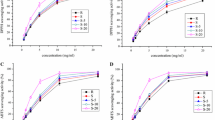Abstract
Energy crops offer enormous opportunities for increasing the sustain ability of agriculture and energy production in the United States. Nevertheless, opportunities for sustaining biomass energy production may well hinge on producing energy and extracting high-value products from the same crop. Seven potential energy crops (mimosa, sericea, kudzu, arunzo, switchgrass, velvetbean, and castor) were extracted and assayed for the presence of potentially high-value antioxidant compounds. Of these crops, mimosa and sericea had the highest antioxidant potential and were selected for further study. High-performance liquid chromatography (ultraviolet) and liquid chromatography/mass spectrometry techniques were then utilized to help identify the compounds with high antioxidant potential using extract fractionation, and total phenolics and oxygen radical absorbance capability assays as a guide. These analyses indicate that methanol extracts of mimosa foliage most likely contain quercetin, a flavonol that has been associated with cardioprotection. Future work will concentrate on quantifying the quercetin content of mimosa (likely parts-per-million levels), as well as identifying and quantifying other antioxidants found in energy crops.
Similar content being viewed by others
References
Sladden, S., Bransby, B., Aiken, G., and Rose, P. (1992), Highlights Agric. Res. 39, 4.
Kinjo J., Araki, K., Fujui, K., Higuchi, H., Ikeda, T., Nohara, T., Ida, Y., Takemoto, N., Miyakoshi, M., and Shoji, J. (1992), Chem. Pharm. Bull. 40, 3269–3273.
Naidu A. (2000) Natural Food Antimicrobial Systems, CRC Press, Boca Raton, FL.
Singleton, V. L. and Rossi, J. A. (1965), Am. J. Enol. Vitic. 16, 144–158.
Cao, G. H. and Prior, R. L. (1999), Methods Enzymol. 299, 49–62.
Van der Sluis, A. A., Dekker, M., Skrede, G., and Jongen, W. M. F. (2002), J. Agric. Food Chem. 50, 7211–7219.
Meyer, A. S., Heinonen, M., and Frankel, E. N. (1998), Food Chem. 61, 71–75.
Chan, M. M-Y., Mattiacci, J. A., Hwang, H. S., Shah, A., and Fong, D. (2000), Biochem. Pharmacol. 60, 1539–1548.
Binsack, R., Boersma, B. J., Patel, R. P., Kirk, M., White, C. R., Darley-Usmar, V., Barnes, S., Zhou, F., and Parks, D. A. (2001), Alcohol. Clin. Exp. Res. Online 25, 434–443 (Website: http://fn.cfs.purdue.edu/bot/Downloads/Publications/Binsack_quercetin_ACER_2001.pdf).
Careri, M., Corradini, C., Elviri, L., Nicoletti, I., and Zagnoni, I. (2003), J. Agric. Food Chem. 51, 5226–5231.
Author information
Authors and Affiliations
Corresponding author
Rights and permissions
About this article
Cite this article
Lau, C.S., Carrier, D.J., Howard, L.R. et al. Extraction of antioxidant compounds from energy crops. Appl Biochem Biotechnol 114, 569–583 (2004). https://doi.org/10.1385/ABAB:114:1-3:569
Issue Date:
DOI: https://doi.org/10.1385/ABAB:114:1-3:569




